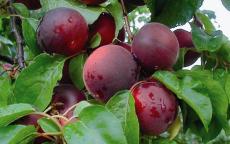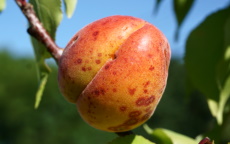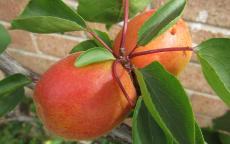Apricot trees
Grow your own delicious apricots with our selection of apricot trees, carefully selected for the UK climate. Buy online with expert advice and UK delivery.
Aprikyra®
A sweet self-fertile apricot-cherry cross, also known as an Aprichery or Cherrycot- Self-fertility: Self-fertile
Aprisali®
A sweet self-fertile apricot - plum cross, also known as an Aprium.- Picking season: Mid
- Self-fertility: Self-fertile
Early Moorpark
A traditional English apricot from the 19th century.- Picking season: Mid
- Self-fertility: Self-fertile
Golden Glow
A modern English apricot, found growing as a chance seedling near Worcester.£43.75buy- Picking season: Early
- Self-fertility: Self-fertile
Helena du Roussillon®
A traditional French apricot variety, grown in the Languedoc-Roussillon area.£43.75buy- Picking season: Late
- Self-fertility: Self-fertile
Pink Marry
A new red-flushed apricot which ripens in early July.£43.75 - £66.50buy- Picking season: Early
- Self-fertility: Partially self-fertile
Tomcot
Tomcot is a modern apricot variety with large fruits, suitable for planting in warm dry areas of the UK.- Picking season: Early
- Self-fertility: Self-fertile
How to choose Apricot trees
Apricots trees belong to the species Prunus armeniaca, and originate from central Asia, where they have been cultivated for thousands of years. Most commercial production takes place in Turkey, southern Europe, and California.
Apricots have excellent nutritional and medicinal properties, and contain more concentrations of beneficial compounds than most other fruit. They are one of the best natural sources of Vitamin A.
Apricot trees are easy to grow in warm climates but can be a more challenging in temperate climates such as much of the UK and northern Europe. The main problem is not winter cold - all Apricots are very hardy - but inconsistent and variable weather, especially in late autumn and early spring, and too much rain. Apricot trees prefer a simple regime of cold dry winters (with at least 500-700 hours below 5 degrees centigrade) and hot dry sunny summers. They do not like either the cold of winter or the heat of summer to be interrupted, and mild weather in late autumn or cold weather in late spring can be a challenge for them.
The recent mild winters have been particularly difficult for apricot trees in the UK. Keep an eye on the weather in November and December - if temperatures do not fall far enough and fast enough the trees do not become dormant. Then when a period of real cold finally arrives the trees are still growing and areas of younger growth are then left open to bacterial canker infections, to which apricots are very susceptible. If you suspect your apricot tree has not become dormant by December, try to protect the tree with fleece over the winter. This is not necessary if the tree is properly dormant though, since apricots are very cold-hardy.
The other challenge can be frost injury to the blossom, because apricots flower very early in the spring, before there are many pollinating insects about. Hand pollination with a small soft brush is therefore often necessary in the UK - do this over 2-3 days when the weather is dry. Keen gardeners will also use frost fleeces on nights when frost is forecast, to avoid frost damage to the blossom. It also helps to choose a sloping site where cold air can drain downhill away from the tree.
The main disease of apricot trees in the UK is bacterial canker, which produces dieback and rapid shoot death. This disease is favoured by mild wet weather over the autumn and winter, and trees are especially susceptible if the late autumn weather is too warm. You can reduce the risk of infection by making sure the planting area is well-drained. Sites where standing water can accumulate over winter should be avoided. In addition, try to keep the rain off them, particularly over the autumn and winter (this helps prevent bacterial canker infections). If dieback occurs it is easily treated if you catch it early - just prune out the damaged branch.
Apricots are the earliest fruit trees to flower. The apricot blossom season lasts for about 3-4 weeks, starting in late February. The flowering periods of most varieties overlap to a greater or lesser extent, with only the very earliest (e.g. Flavorcot) and very latest (e.g. Bergeron) not likely to overlap. There is a gap of several weeks between the blossom finishing and the new leaves starting to emerge.
All apricots are self-fertile, and you only need to plant one tree to get a crop. However planting two trees (each of a different variety) will often produce heavier crops, as well as spreading the risk of frost damage.
Keep pruning to an absolute minimum, and where it is necessary to prune, only do so in late spring when thinning the fruitlets, or just after picking. Although the UK climate means fruiting is sometimes erratic, apricot trees are generally healthy and hardy.
Like plums, apricots may sometimes over-crop, particularly if the spring weather has been good. If this happens then be sure to thin the fruitlets - the ones that remain will be bigger and more flavoursome as a result. Tree-ripened home-grown apricots have a rich fruity flavour that is difficult to beat.





